Since the late 90s, when Apple introduced the PowerPC G4 and Intel introduced the Pentium III, there has been a severe performance gap between the venerable Macintosh and the ubiquitous PC. Not only did the Pentium III have a higher clock speed than Apple's G3 or G4, but its performance per clock also increased. The days of Apple/IBM/Motorola (henceforth AIM) triarchy in the microprocessor business were at an end, its pinnacle reached with the Mach V, a PowerPC 604 variant that outperformed the Classic Pentium, MMX Pentium, and Pentium Pro clock-for-clock. With plans for the Mach VI and Mach X (the PowerPC 604r and 605, respectively) canned, Intel took sweeping strides toward the throne of CPU superiority and has held on with an iron grip ever since.
What Motorola doesn't want you to know is that this obsolescence was planned from the beginning of its involvement in the PowerPC fiasco. Owing to spite and jealousy over Apple's choice of IBM's PowerPC architecture over its own Ripfire 88k series, Motorola decided to trumpet Apple's decision despite the fact that it had something better Apple desperately needed at that point in time: the M68060, the sixth CPU in the hot 68k family. Keeping its hands quietly in its pockets and staring at the floor in silence, Motorola remained mum on the new specs for the '060 and let Apple purchase the PowerPC 601 from IBM, which would act as a time bomb set to destroy Power Macintosh performance.
The PowerPC 601 was the Piltdown Man of its family: it bridged the gap between the older POWER instruction set architecture (ISA) and its direct successor, the PowerPC ISA; in fact, the 601 actually included some POWER instructions and emulated others by stringing together PowerPC instructions—it could run binaries compiled for POWER chips unmodified. This little dynamo also out shined the Pentiums of the day, which ran at 50, 66, and 75 MHz. The 601 was generally 1.2-1.5 times as fast as a Classic Pentium at the same clock speed. Apple and IBM were pleased while Motorola snickered silently in the shadows: their M68060 was running circles around both the Pentium and the PowerPC 601 in a beast called the Amiga. To put it in perspective, the '040 and '060 Amiga lines actually used PowerPC chips as text co-processors!
As Intel glacially moved from the Classic Pentium to the MMX-enhanced Pentium (and also down-clocking the new line), AIM released the PowerPC 602, 603, 604, and 620 parts, all designed to conquer niches in the market that the stop-gap 601 could never be specialized for. The 602 was used in stadium scoreboards, remote-controlled Transformers, and the popular Nintendo64. The 603 was a very power-friendly chip and could turn its various subsystems off and so was used in low-end desktops, laptops, and network computers. Its older brother, the 604, was created to compete with the secret P6 project that would eventually produce the monstrous Pentium Pro. Finally, the 620 was a 64-bit überzilla with support for up to 128 MB of L2 cache and top clock speeds exceeding 200 MHz.
Years later, in 1997, the PowerPC 602, 603, 604, and 620 chips had either been canned or were severely losing steam. In a seemingly clever move, AIM took the 603 and augmented it. The result was the PowerPC 750, which came to be known as the G3. Motorola's plan to sabotage Apple's desktop performance had just been realized. By the end of the year, Apple was selling Power Macs that ran at 233 and 266 MHz while the last of its PowerPC 604-based line had been running at 350 MHz! Aside from the obvious fabrication limitations of the G3, it also ran slower per clock than the 604 had. Of course, with Apple's interim CEO Steve Jobs at the helm, Mac users did not question this blatant paradox. G3 systems were snatched up by the thousands.
Presently, it is clear that Motorola's nefarious plot has almost come to its fruition. Apple just recently reached 1,000 MHz while the Intel (and now also AMD) attained clock rates of 2,400 MHz in the same time frame. Motorola injected additional roadblocks into Apple's plans by not letting it move away from the abysmally performing 603 core—the G4 was just a hacked-up G3 with AltiVec and an FPU borrowed from the outdated 604!
It is clear that for Apple to survive, it must look beyond Motorola's PowerPC: IBM's own processors would be a good choice, and a logical one at that. One thing remains plain: Motorola is slowly killing Apple—from the inside.
